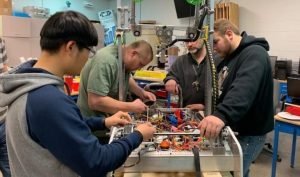Masters in robotics: Admissions, Tuition and Salary

Robotics is a branch of computer science and engineering concerned with the design, manufacture, operation, and application of robots. Robots are automated machines that can help humans in a range of situations, ranging from manufacturing operations to working in hazardous environments. Robotics experts strive to accomplish a variety of tasks by creating mechanical systems that are capable of completing them intelligently. Other research subfields that are related to robotics include computer science, character animation, machine design, cognitive science, and biomechanics. Android science, artificial intelligence, nano-robotics, and robot surgery are the main subcategories of robotics. Keep reading for comprehensive analysis of masters in robotics.
Related Post:How Long does it take to get an MBA Online ?
Students will learn about computer graphics, gadgetry, mobile robot programming, robotic motion methods, mathematical algorithms, social consequences of technology, and more while studying robotics. Graduates will obtain skills that include mathematical thinking as well as creative vision, in addition to studying specialized scientific methodologies. Robotics will train specialists in areas such as technology design, programming, machine repair and installation, and so on.
Robotics careers span a wide range of disciplines, from medicine to engineering and information technology. Laboratory assistants, testing technicians, quality assurance workers, programmers, systems controllers, and researchers are common careers for robotics graduates.
Courses and Skillset.
Engineering Mathematics: You must have a great grasp of mathematics when applying for a field like robotics. Knowledge prerequisites for advanced engineering mathematics include concepts such as Fourier series, Laplace transformation, and linear algebra, among others.
Basic Electronics: Electronics may appear frightening, but they aren’t as horrible as they appear, and they are an essential component of robotics. Whether it’s a simple battery or a microcontroller, it’s important to understand how electronic components work and where they should be used.
The power of Other disciplines that are important in robotics and go hand in hand are machine materials and design. One should be familiar with the materials that can be utilized to build a robot. Also, how to design robots with that material.
Coding/programming: In robotics, programming functions as the robot’s brain. It will be done through a piece of code, whether you want it to travel forward or backward. As a result, if you want to work with robots, you’ll need to know how to program.
Design Software: If you’re interested in robotics, having a great grasp of design software will help you stand out. Regardless of whether you use ANSYS or Hypermesh, you should be able to use a modelling suite to produce a virtual model of a robot that includes the design and programming code.
Simply said, it just takes one bad connection to stop an electronic item from working, and you could wind up tossing the circuit board or the gadget away. Instead of buying a new appliance, if you know how to solder, you can really fix it by making the proper connection. Soldering is a key talent in a subject like robotics, and it is one of the most important skills.
Prerequisites for Admission
After you’ve decided on a country, university, and program, you’ll need to take care of a few additional things before moving further, such as the entrance exam and the passport and visa process. It could take another year to complete the procedure. Prepare thoroughly for all of the procedures, leaving no stone untouched. This period of waiting and preparation is regarded as one of the most crucial.
Entrance Exams: When applying for a Master of Science in Robotics at a foreign university, you must pass tests such as the GRE or GMAT. There’s no doubting that if you want to go to a top-ranked university, you’ll need to have strong test scores — a GRE score of 320 or higher is ideal. In most cases, you’ll also need to pass the English language exam, which must be completed within two years of the program’s application deadline. TOEFL or IELTS are the English entry exams to take, depending on the country. When applying to a foreign university, a TOEFL score of 100 or higher and an IELTS score of 7 or higher are deemed enough.
Related Post:How much does Trade School Cost?
Required Documents:
Proof of financial support: Applicants seeking a student visa must show proof of financial support. If the funds are not in the student’s name, a statement of support from a sponsor may be necessary.
Passport information and international contact information: A valid passport is required, as well as proof of international address, by most foreign universities.
SOP (statement of purpose): An SOP is a document that tells the admissions committee about your interests and experiences. It is also a must-have document that should not exceed two pages in length.
Résumé: Some colleges require a resume or a CV, which must be updated with all necessary information, including educational and professional experience.
Letters of recommendation: Letters of recommendation from people who can attest to the applicant’s previous work quality and likelihood of success in the program are also required. Most institutions require two to three letters of recommendation.
Transcripts and academic records: Applicants must also submit an original or scanned copy of their transcripts from each institution or university attended. The documentation must be written in the university’s native language plus an English translation. Proof of enrollment is required if the candidate is still pursuing a bachelor’s degree.
List of Robotics Jobs for Masters Degree Holders
Machine Learning Engineer
Machine learning experts use artificial intelligence techniques, such as data modeling and algorithmic analysis, to create systems and software that operate without the need for human intervention.
Research Scientist
Computer scientists do in-depth study to address issues in computing and technology advancements. They create models and guidelines for resolving computing issues. These professionals create software and hardware components that make it easier to use technological equipment.
Data Analyst
These are professionals who use their superior computing, research, and analysis skills to sift through massive amounts of data. Algorithms and modeling are used by these individuals to provide useful insight into computer trends and technology.
Robotic Engineer
Spacecraft, missiles, aircraft, and satellites are all examples of aerospace machines and devices that are designed and built by aerospace engineers. This group of people creates machine prototypes and tests them for reliability. Based on client requirements, they create product quality standards and design techniques.
Sales Engineer
Sales engineers are sales and marketing experts who specialize in selling engineering products and services to organizations. They have a thorough understanding of the functionality and performance of these engines, which allows them to accurately specify the system requirements.
Software Engineer
To design and build software applications and devices, software engineers employ a variety of programming languages as well as fundamental components of systems engineering. These individuals use their knowledge of software design, programming experience, and computer engineering to create mobile and web applications.
Related Post:Hospitality Management Degree: All you need to know
Robotics Engineer
Robotic engineering is a field of mechanical engineering that focuses on the development of advanced robotic technologies. Robotic engineers design self-automated robotic systems that handle massive amounts of data, mimic human interaction, and apply thought patterns to solve complicated issues and assist humans in executing tasks.
Designer (UX/UI)
These site designers build helpful graphical interfaces and user experience apps to make software and system devices easier to use. They accomplish this by conducting comprehensive market research and completing the app’s creation using their creativity, communication abilities, and psychological analysis.
Mechanical Engineer
Mechanical tools, engines, and gadgets are developed and managed by these professionals. They do extensive study and analysis to figure out how and what sensors and gadgets may be employed to solve real-world problems. Mechanical engineers create gadget modifications based on research and current trends.
Programmer
Experts who write code and scripts that define how software applications and systems work are known as computer programmers. They install new code, configure it, and test it to ensure that it works properly. They collaborate with development teams to create software and systems that are both efficient and dependable.
Is a Robotics Master’s Degree Worth It?
Yes, if you want to advance your career in robotics, you should get a master’s degree in robotics. Advanced degrees in robotics can provide you with opportunities in the field of robotics that no other educational path can, as well as the knowledge to create new and exciting technology.
The average salary for robotics graduates is commendable. When you combine that with a promising job outlook for engineers and scientists working in artificial intelligence, you know you’re on the right track.
How much does a master’s degree in robotics cost?
A master’s degree program costs an average of $18,416 per year, according to the National Center for Education Statistics. Depending on the program you select, this number will be different. A public university is usually less expensive than a private university.
Universities offering Masters in Robotics
Pomona State Polytechnic University is a California State Polytechnic University located in Pomona, California.
Cal Poly Pomona is the abbreviation for California State Polytechnic University in Pomona, California. The public institution is one of two polytechnic colleges in the California State University system, and it is located in the greater Los Angeles metro region about thirty miles east of downtown Los Angeles. The university was created in 1938 and now has roughly 24,000 undergraduate students. Cal Poly Pomona’s engineering department is well-regarded, producing one out of every 14 engineers in California. In the U.S. News 2020 edition of Best Colleges in Regional Universities West, Pomona was placed #31.
Cal Poly Pomona’s Electrical and Computer Engineering (ECE) department provides a Master of Science in Electrical Engineering (MSEE) with a Control and Robotics Systems option. Through advanced elective courses, students gain a broad range of advanced foundation courses as well as focused information pertinent to their fields of concentration.
Cornell University is located in Ithaca, New York
Cornell University is a private research university in Ithica, New York, founded in 1865. The school holds the unique distinction of being an Ivy League university, a federal land-grant college in New York State, and a State University of New York partner authorized by the New York state legislature to receive continued public financing.
Cornell provides a one-year Master of Engineering (M.Eng.) in Mechanical & Aerospace Engineering with a specialty in Dynamics, Controls, and Robotics through the Sibley School of Mechanical and Aerospace Engineering. The multidisciplinary curriculum prepares students for professional work after graduation by helping them establish a high level of competency in engineering science, current technology, and engineering design. Students pursuing the specialization study classes in Mechatronics, Autonomous Mobile Robots, Systems Engineering, Nonlinear Vibrations, Model-Based Estimation, Multivariable Control Theory, and Applied Dynamical Systems, with a concentration on Dynamics, Controls, and Robotics. Cornell’s robotics research covers several departments and focuses on various elements of designing and managing robots, including mechanical design, dynamics, perception, control, and decision making. Aerial robots, snake robots, home helper robots, autonomous autos, humanoids, and evolutionary robots are among the robots that students can work with at Cornell.
The Massachusetts Institute of Technology (MIT) is a public research university
The Massachusetts Institute of Technology, or M.I.T., is a private research university in Cambridge, Massachusetts, founded in 1861. The school is tiny, with roughly 4,500 undergraduate students enrolled each year. The university’s annual research budget exceeds $650 million and is located outside of Boston in Cambridge, Massachusetts. Graduate students interested in robotics can take advantage of several options at MIT’s highly regarded School of Engineering. The school’s graduate programs, on the other hand, are not for the faint of heart. An MIT graduate student is expected to make a difference in the world.
The Master of Science in Mechanical Engineering (SMME) is one of nine graduate degrees offered by the MIT Department of Mechanical Engineering (MechE). The project-based curriculum emphasizes problem-solving and hands-on experience. Graduate students at MIT have access to research opportunities with world-class faculty in cutting-edge labs and facilities. The Robot Locomotion Group and the Biomimetic Robotics Lab are two notable MIT robotics groups and labs focused on creating machines with outstanding agility and efficiency.
University of Michigan, Ann Arbor campus
The Institution of Michigan – Ann Arbor is a public university in Ann Arbor, Michigan, roughly 45 minutes from Detroit and one of America’s top college towns. The university was founded in 1817 and currently has a student body of roughly 29,000 undergraduates. With a reputation for brilliance in scholarship, research, and invention, it’s no wonder that the University of Michigan has developed a distinctive approach to robotics instruction. Michigan Robotics is a department within the College of Engineering that brings together roboticists from mechanical engineering, electrical engineering, and computer science. Students and teachers collaborate to share issues and answers, as well as to speed the development of new robotics capabilities. Michigan Robotics provides master’s and doctorate degrees in robotics.
30 credits of courses, including 3 to 6 credits of directed study, are required for the Robotics Masters (MS) degree. Sensing, reasoning, and acting are the three main subdisciplines or technical topics in the Michigan Robotics program. These are also the three graduate study options. These fields converge as students build working robots. Robotic External agents and internal body information are used to determine state information in environmental sensing, which includes computer vision and signal processing. Machine learning, planning, multi-agent coordination, and artificial intelligence are all used in robotic reasoning to make judgments for guidance, control, and localisation. Control, kinematics, dynamics, mechanical, bio-mechanical systems design, manipulation, and real-time systems are all part of robotic acting, which allows a robot to locomote or interact with the environment by producing motion or other outputs.
The University of Pennsylvania is located in Philadelphia, Pennsylvania.
Benjamin Franklin created the University of Pennsylvania (UPenn) in 1740 as a private college. It is located in the city of Philadelphia and has an annual undergraduate enrollment of 10,000 students. UPenn was founded with Franklin’s lifelong interest in innovation and invention in mind, with the goal of bringing scientific education to the American colonies. While not all of Franklin’s Enlightenment-era dreams came true, his spirit lives on in the university’s commitment to cutting-edge, paradigm-shifting research.
The School of Engineering and Applied Science at the University of Pennsylvania offers a Master’s Degree in Robotics (ROBO). The GRASP Lab, one of the world’s top robotics research facilities, administers Penn’s ROBO master’s program, which is funded jointly by three university departments – Electrical and Systems Engineering, Mechanical Engineering and Applied Mechanics, and Computer and Information Science. This internationally recognized robotics engineering degree for graduate students trains students in robotics science and technology and serves as a foundation for additional graduate studies or employment in a range of industries. Students from a variety of educational backgrounds, including engineering and computer science, are drawn to the ROBO program. The only requirement for applicants is a love of robots!
Related Post:Online Masters in Sociology








